Trending
Opinion: How will Project 2025 impact game developers?
The Heritage Foundation's manifesto for the possible next administration could do great harm to many, including large portions of the game development community.
Sega's Panzer Dragoon series proved both short-lived and beloved, with developers and fans alike entranced by the series' unique, organic world view - Gamasutra presents a comprehensive design history of the franchise.

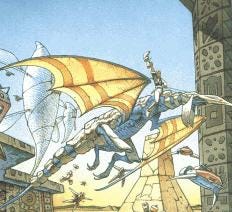 The early days of the Saturn were dark indeed. Sega was primarily counting on home conversions of Virtua Fighter and Daytona USA to carry its hype, especially during the summer of 1995, when it was surprisingly launched at a rather pricey $400. Although fans gobbled them up, Namco had a one-two punch of Tekken and Ridge Racer, which were being released for Sony's brand new PlayStation.
The early days of the Saturn were dark indeed. Sega was primarily counting on home conversions of Virtua Fighter and Daytona USA to carry its hype, especially during the summer of 1995, when it was surprisingly launched at a rather pricey $400. Although fans gobbled them up, Namco had a one-two punch of Tekken and Ridge Racer, which were being released for Sony's brand new PlayStation.
Despite not having quite the same level of arcade street cred, they both looked much better, and helped begin Sony's dominance in the console gaming field. Meanwhile, Sega scrambled to make its Virtua Fighter port look less embarrassing with the release of Virtua Fighter Remix, and tried to create a number of other properties such as Clockwork Knight and Bug!, neither of which were terribly impressive.
In these dark early days, one of the only truly original titles that Sega fans could get excited about was Panzer Dragoon, created by a Sega team known as Team Andromeda. Although it was specifically designed for the home console, Panzer Dragoon felt much like an arcade game -- it was short and shallow, but remarkably pretty, at least for the time.
In many ways, Panzer Dragoon is a light-gun game without the light gun -- the gamer term for this is a "rail shooter." Although you pilot a flying dragon, the game's path is completely pre-calculated, so all you need to do is shoot at enemies and dodge incoming fire.
In all games, you have two weapons -- a standard gun, and a lock-on laser, which is activated by holding down the fire button, targetting several enemies, then releasing. You'll then send out a homing laser which decimate -- or least badly wound -- whatever is in your sights. The only real freedom you have is the ability to turn your viewpoint for a 360 degree view of the landscape as you fly over the game's desolate landscape, which is activated by hitting the left or right trigger buttons.
Since enemies come from all angles, being able to shoot in any direction is key to survival. However, it also contributes to one of Panzer Dragoon's biggest issues -- sometimes, there's just way too much going on at once. Short of spinning the view around rapidly, the only way to detect incoming enemies is by paying attention to the radar at the top of the screen. Before you get used to it, you'll find yourself tracking the enemies' position frantically, until you can finally target them, only to find out that they've already fired off a few shots and done some damage to your dragon.
In many cases, the most efficient way to combat enemies is simply to play through the levels over and over, and memorize when and where the enemy formations pop up. It's frustrating to get the hang of at first, but the learning curve is almost a necessity, because the Saturn Panzer Dragoon games are remarkably short, and they needed some kind of staying power.
There are other issues that take some adjusting -- you don't directly control your dragon, but rather, you control the targetting cursor, and the dragon just sort of follows. It's strange to feel the disconnect between the beast you're piloting, especially if you're more familiar with similar games like Nintendo's StarFox 64. It doesn't help that trying to dodge enemy attacks can be quite difficult due to both the controls and perspective -- most of the time, it's better just to try to shoot down enemy projectiles than rather dodge them, which can occasionally be a fruitless affair.
Despite these quirks, Panzer Dragoon is still remarkably fun to play, and most of this lies within its gorgeous visuals. The Saturn wasn't exactly a 3D powerhouse, and the installments for that system look a bit aged, but the actual artwork is spectacular. Drawing inspiration from the works of French artist Moebius (who provided some illustrations for the original game), Hayao Miyazaki's Nausicaa of the Valley of the Wind, and David Lynch's Dune movie (complete with sandworms), the world of Panzer Dragoon consists of expansive, barren landscapes filled with strange beasts and other monstrosities out to destroy the remnants of humanity.
It's a masterful blend of fantasy and science fiction that's rarely pulled off in any medium. The levels stretch from expansive oceans to barren deserts to the winding tunnels of lost ruins. It takes a lot of effort on the graphic designers part to take such dark and dismal landscapes and turn them into something of beauty. Also, the enemies in Panzer Dragoon don't just explode when they die -- they literally fall apart at the seams. There's rarely a thing more satisfying than targetting a whole school of flying fish-things, hearing the beautiful chirp of the lock-on cursor, unleashing a hellstorm of lasers, and watching the dismembered chunks of your former foes fall helplessly to the ground.
Panzer Dragoon takes place in a post-apocalyptic world where most of the land is barren, save for expansive, empty oceans. It seems that humanity brought about its near-demise through some nasty genetic tinkering, resulting in strange monsters that overrun the planet. Most of the game's plot revolves around the relics and ruins left behind from humanity's prior age, especially huge structures called Towers, which control great portions of the land.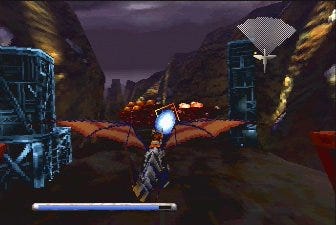 Nearly all of the game's dialogue is spoken in what has been dubbed "Panzerese", a made-up language which is apparently a combination of Ancient Greek, Latin and Russian, which lends to the series' atmosphere.
Nearly all of the game's dialogue is spoken in what has been dubbed "Panzerese", a made-up language which is apparently a combination of Ancient Greek, Latin and Russian, which lends to the series' atmosphere.
The music is the first game has some stirring orchestral pieces, but the rest of the music primarily consists of synthetic beats reminiscent of Vangelis' Blade Runner score or Toto's work on the Dune movie. Although much of the music is subdued, especially in the later games, the atmosphere is carried by tribal drum beats and electronic versions of other wind instruments, which further enhances the exotic world of Panzer Dragoon.
In video game music circles, the soundtracks and their composers -- primarily Saori Kobayashi, who is responsible for most of Panzer Dragoon Saga and Orta -- are often held in as high regard as the games themselves. The game's sound effects also deserve special note, especially the unique painful screech when your dragon takes damage. Whenever you're hit, the dragon flails wildly and whelps in horror before reorienting itself -- you can really feel the impact of every mistake you make.
There are three primary games in the Panzer Dragoon series -- the original, Zwei, and Orta. Panzer Dragoon Saga, also known as Panzer Dragoon RPG: Azel in Japan, is a unique role-playing game that takes the shooter mechanics of the other installments and brilliany weaves them into a deeply strategic battle system. All of these were released on the Saturn, except for Orta, which was released on the Xbox. There is also a throwaway Game Gear spinoff, and a really, really bad anime.
The opening cinema of Panzer Dragoon -- rendered on the Saturn in a small window with blocky FMV -- relates the story of two young men hunting in the desert, one of whom is the hero, Keil. They look up, and find two dragon riders dueling in the skies. Keil's friend is accidentally killed, leaving our hero stranded in a cave, about to be eaten by some of the world's nastiest monsters. Before his death, one of the dragons flies by and carries him to safety. The rider is dying, but in his last words, he begs Keil to take his beast and follow his opponent, the evil black dragon, before he reaches the Tower and causes mayhem.
Compared to the later entries in the series, the original Panzer Dragoon is a bit cut and dried -- the only weapons are your standard gun and homing laser, there aren't any options to speed up or slow down, and there are only six completely linear levels. Additionally, from a 2008 perspective, it takes awhile to get used to the choppy framerate, and the lack of analog control is annoying.
Despite feeling barebones, it's still a remarkably fun game. The Easy Mode only lets you play to the end of level four -- Normal Mode and beyond lets you plat the full game, but it's pretty difficult. Although the levels are only about five minutes long each, it's a pain to get to the boss, die, and have to start all over, especially since there are no life power-ups. You get a limited number of credits, although you gain more at the end of each level based on how many enemies you've killed. Strangely, there are some minor differences in the difficulty levels between the Japanese and Western releases, with the Western version generally being more difficult.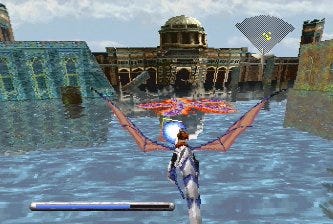 For awhile, Sega was actively porting many of its console and arcade games to the PC, with varying degrees of success. The Windows port of Panzer Dragoon has a bad reputation, but it's basically the exact same game -- choppy framerate included -- running at a higher resolution, so it looks crisper. It's a nice, dirt cheap alternative to the other versions.
For awhile, Sega was actively porting many of its console and arcade games to the PC, with varying degrees of success. The Windows port of Panzer Dragoon has a bad reputation, but it's basically the exact same game -- choppy framerate included -- running at a higher resolution, so it looks crisper. It's a nice, dirt cheap alternative to the other versions.
This version was included as an unlockable in Panzer Dragoon Orta for the Xbox, which also runs at a higher resolution than the Saturn version, so it looks a bit better. The ability to use the analog stick is nice (the Saturn one only supported the system's digital pad) even though it's not technically true analog control.
Panzer Dragoon also was treated to a rerelease in 2006 for the Japanese PlayStation 2 as part of the Sega Ages 2500 budget line-up. It includes a "Saturn Mode" with graphics similar to the original game, and an "Arrange Mode" which features anti-aliased graphics, better texturing and some improved polygon models, mostly notably the dragon. Both versions now feature control with the analog stick, although again, it's not true analog.
Unfortunately, despite the opportunity to fix some issues, the draw distance is still fairly short, and the frame rate hasn't improved at all. Some of the minor effects, like the rolling ocean waves in the first stage, don't look quite right either. It's a nice package overall, and probably the best looking of all of the versions, but it's not substantially better than any of the other versions. The major bonus is the addition of the Pandora's Box bonus menu, which features a bunch of artwork, as well as a full replay of the entire game by an expert.
Panzer Dragoon Zwei, released a year after the original, tells the story of a human named Lundi and his dragon Lagi. His village has ordered that all dragons be destroyed, but he hides his pet and raises it in secret. As one might expect out of a video game plot, Lundi's village is later destroyed by a mysterious airship, so the only option is to exact revenge.
Since Lavi isn't fully grown at the beginning of the game, he can't yet fly, and the first couple stages are entirely ground-based. This leads to one of the game's most impressive moments, where the creature charges off a steep cliff and spreads its wings for the first time. The whole moment is perfect -- the music stops, and you seem you be taking a nosedive straight to your death, and maybe think you did something wrong, but it shakily straightens itself out, glides over the vast, empty expanse of the landscape, and provides a safe landing. It's not until the third stage where your dragon can fly properly, and even then, certain segments of later levels are ground-based.
Panzer Dragoon Zwei introduces the Berserk Attack -- by killing enemies, you'll slowly build up a power meter, which can be unleashed when it reaches a certain level, attacking everything on the screen for a short amount of time.
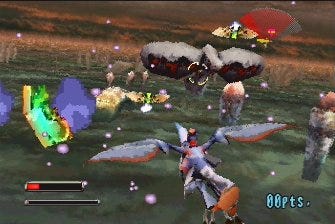 Since you can now save your game, essentially enabling unlimited continues, your performance will affect how quickly your dragon evolves into more powerful forms. There are also multiple routes throughout each level, which also greatly expands replayability. Some of these elements are a bit confusing, because the grading system for evolution doesn't really make too much sense (you're graded on Clear, Route, and Technical aspects, which are pretty nebulous unless you've read up about them), and it's difficult to determine where the route forks are.
Since you can now save your game, essentially enabling unlimited continues, your performance will affect how quickly your dragon evolves into more powerful forms. There are also multiple routes throughout each level, which also greatly expands replayability. Some of these elements are a bit confusing, because the grading system for evolution doesn't really make too much sense (you're graded on Clear, Route, and Technical aspects, which are pretty nebulous unless you've read up about them), and it's difficult to determine where the route forks are.
On a technical level, the graphics have improved only marginally, although the frame rate seems to be a bit smoother. The music is much the same style, although it lacks any orchestral tracks, and overall isn't quick as memorable. The Pandora Box menu (mistranslated as "Pandra's Box" in the English version), which shows up in later Panzer Dragoon titles, was introduced here. Unlocked once you beat the game, it's basically a convenient cheat menu, which lets you change difficulty levels, increase your life or berserk meters, give you all kinds of new weapons, change levels, and tons of other bonus goodies, including promotional videos. Since the game is still fairly short, it gives an incentive to dive in and mess around at your heart's content.
All throughout the Saturn's life, the system struggled for an RPG to define it, in comparison to the alliance of Final Fantasy and Dragon Quest on the PlayStation. Many fans felt GameArts' Grandia would be Sega's flagship RPG; that was later ported to the PlayStation, where it received its only release outside of Japan.
Instead, that role ended up going to Panzer Dragoon Saga, one of the last titles officially published by Sega for the system. Panzer Dragoon Saga takes the vibrant world found in the previous games and fleshes out its back story, filling four CDs worth of cinematics, and telling the story of a young dragon rider named Edge.
At the beginning, Edge is working at an excavation site for the Empire, until he's attacked by a rogue squadron of soldiers looking for a mysterious artifact. Despite being flung into a chasm, he awakens unharmed, and ends up stumbling upon a dragon, who flies him out to safety. He begins his journey to find the man who nearly killed him, a rebel soldier named Crayman, and discover the secret behind the artifact that his crew was massacred over.
During the initial attack, Edge notices a beautiful young girl frozen into the wall, much like Han Solo in carbonite. We eventually learn that she is named Azel. She's abducted by Crayman's army for reasons that are rather unclear. She later appears riding a powerful beast known as the Atolm Dragon, and immediately targets Edge as her enemy. She appears to have been brainwashed, although only Edge can set her straight before she unleashes terrible devastation upon the world.
Panzer Dragoon Saga is unlike any other RPG for any other system. Other than Edge and his dragon, there aren't any other party members, although NPCs will occasionally hop onboard for the ride. Although there are sections where you run around on foot (mostly in the few towns throughout the world), most of the game -- both battle and exploration -- takes place riding on the back of your dragon. Unlike the on-rails action of the previous games, Saga actually lets you fly around and explore the many details areas of the Panzer Dragoon world, lending a lot more freedom to the experience.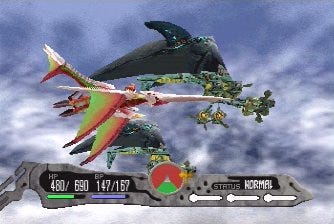 The battle system is one of the most remarkable aspects of Panzer Dragoon Saga. The action takes place in real time, with three power bars that charge over the period of a few seconds. When a single bar charges up, you can make your move.
The battle system is one of the most remarkable aspects of Panzer Dragoon Saga. The action takes place in real time, with three power bars that charge over the period of a few seconds. When a single bar charges up, you can make your move.
There are two standard attacks -- Edge's gun targets a single enemy with heavy damage, while the dragon's laser targets multiple foes with lessened damage. There are also several Berserk powers, which act as the equivalent of magic spells. If you want, you can wait to build up two or three power bars to attack multiple times at once. Certain Berserk attacks also drain multiple bars. Similarly, the enemy can attack after it's built enough energy, although you can't determine when that is.
During combat, you're positioned in one of four quadrants surrounding your enemies, and can move between them at will, although this momentarily stops the power gauge. A radar at the bottom of the screen will mark which zones are safe and which are dangerous. If you're flying in a green zone, the enemy can't attack; if you're in a neutral zone, the enemy can use a weak attack, and naturally, the red zone indicates that the enemy can use a fierce attack.
Obviously, you'll want to spend as much time as possible charging in the green zones to avoid damage. However, enemies often have weak points in other positions, encouraging you to fly in the face of danger to finish battles efficiently. The enemy's attack patterns often change multiple times during battle, forcing you to adapt and figure out the optimal positioning, timing, and type of attacks to use.
So, in other words, it's a lot more involving than the typical RPG battle, since you always need to think on your feet. You can also control the growth and powers of your dragon by tinkering with different attributes, which in turn alters your dragon. For example, you can choose to balance your attack power between Edge's gun and the dragon's laser, depending on which you use more often.
You also need to balance between defense and speed -- do you want to be able to take a pounding, or do you want your power bar to charge faster? Depending on how you choose your statistics, your dragon also gains additional powers, such as counterattacking and healing abilities. Although your level-up bonuses change depending on your dragon form, you can change them at any time, including in the middle of battle, so you can figure out what abilities work best against certain enemies.
While there's a ton of depth to the battle system, the constant random battles do tend to become tiresome. There are usually only a few enemy formations in each area, and once you've figured them out, each fight is really just going through the motions. There's no way to run from them either. It doesn't help that most of the "dungeons" themselves are pretty boring. You're either flying -- very slowly -- across a huge, empty landscape, looking for switches to shoot at, or you're exploring very dismal tunnels. At least the map and navigation system is very friendly, so you can't really get lost.
The graphics also show the 3D limitations of the Saturn. Anytime you're on a dragon, the graphics are roughly the quality of Panzer Dragoon Zwei. The dragon itself looks awesome, especially the color of its wings. However, any time you're exploring a town, the quality takes a huge nosedive.
From a design standpoint, the game is still lovely -- the village of Zoah is gorgeously constructed and looks quite nice, especially with all of the lighting effects during the nighttime. But everything is painted with incredibly low res textures, the character models are very boxy, and slowdown is usually pretty common. Controlling Edge on foot is a bit clumsy, and taking any action -- from opening a door to talking to someone -- requires standing still and highlighting the target with the cursor.
The Saturn wasn't exactly a marvel when to came to video, so despite the abundance of cutscenes, most of them don't look too great. They're in a small window, they're heavily compressed, and both the characters and environments reek of mid 90s-quality CG. Despite the fact that they're well-directed, they don't look half as good as anything from Square, and it's a good example of why the Saturn was seen as lacking compared to the PlayStation. Despite the game filling four discs, the quest is quite short, pretty linear, and also a bit on the easy side.
All of the cutscenes are voiced, which puts the action beyond any of the Final Fantasy games of the time. Although the introduction is in Panzerese, the voices switch over to Japanese once gameplay starts. To cut down on localization costs, the Japanese voices were kept for the English version. The music is pretty similar to Panzer Dragoon Zwei, with a large number of battle themes depending on the area and enemies. Most of the rest of the music is more muted and leans towards the atmospheric side, but it's very distinctive and does its job nicely.
Overall, Panzer Dragoon Saga lacks quite a bit of polish, both from a technical and a gameplay standpoint. But that shouldn't discount anyone from trying to play it -- the world is still thoroughly entrancing, despite how pixelly it gets, and the battle and development systems are completely worth it for anyone sick of the usual JRPG conventions.
Unfortunately, since this was one of the last games released for the Saturn in America and Europe, it was only printed in limited quantities. The end result is that the English version is now incredibly expensive, usually hovering in the $150 range. Like many Saturn games, the Japanese version is far, far cheaper, but unfortunately will not work with the standard import conversion cartridges, requiring that you either own a Japanese Saturn or get your Saturn modded -- and it's untranslated, of course.
After the death of the Dreamcast, Sega went multi-platform and divided its efforts amongst the three remaining platforms. Most of the mainstream-targeted games went to the PlayStation 2 (Virtua Fighter 4, Shinobi), and the kids titles (Sonic, Monkey Ball, Billy Hatcher) made headway on the Gamecube.
However, Sega targeted its more hardcore offerings (Gun Valkyrie, Jet Set Radio Future, Panzer Dragoon Orta) on the Xbox, probably hoping to help establish Microsoft's console as a successor to the Dreamcast. This didn't quite work, because the system never shook off its stigma as a system for first person shooters and other Western-oriented games, and most of these games flopped.
It's hard to say whether Panzer Dragoon Orta would've been more successful on a different platform -- like the other Sega Xbox titles, it's stuck in pretty much a niche genre, and possibly still would've been ignored. But from a technical standpoint, the visuals hugely benefited from by the superior processing ability of Microsoft's behemoth.
Even though the Panzer Dragoon games looked okay during the burgeoning days of the 32-bit era, time has not been particularly kind to them. Panzer Dragoon Orta fixed this right up with incredibly crisp, colorful graphics and a near rock-steady 60 FPS framerate. It may lack some of the fancy effects found in later Xbox games, but artistically, it's one of the most gorgeous games on the platform, and possibly of the whole generation. The boss battles and enemies were fairly impressive in the previous games, but everything in Orta just blows them away.
The first stage is a journey through a series of canyons, much like the opening levels in Panzer Dragoon Zwei, except under the cover of night during a fierce storm. The second stage is filled with some inexplicably strange wildlife, including the boss creature, which looks like a gigantic flying manta ray with vicious flora growing on its back.
One of the later stages is a trip through some kind of living computer, complete with the trippiest visuals this side of 2001: A Space Odyssey. At one point, you assault a gigantic airship, which has to be several dozen miles long, and destroy its megaweapon, a gigantic tower that indiscriminately causes destruction with a blazing laser. There's imagination bursting our of every stage, even the dark, empty wasteland levels.
But there's more to Panzer Dragoon Orta than just inspiration, as the gameplay has improved significantly. You can now speed up and slow down, a la StarFox 64, which helps avoid certain enemies. You can also use to encircle boss creatures, similar to the battle system in Panzer Dragoon Saga -- finding the best position is usually key to dodging boss attacks and hitting their weakpoints. There are three different dragon forms that you can switch between at any time -- the Base Wing, which works just like dragons in the first two games, with two speed bursts; the Heavy Wing, which has more powerful weapons but can target less enemies with the lock-on laser and can't change speed at all; and the Glide wing, which doesn't have the lock-on laser at all, but has a rapid-fire standard gun with a wide targeting range, as well as three speed bursts.
There are three different dragon forms that you can switch between at any time -- the Base Wing, which works just like dragons in the first two games, with two speed bursts; the Heavy Wing, which has more powerful weapons but can target less enemies with the lock-on laser and can't change speed at all; and the Glide wing, which doesn't have the lock-on laser at all, but has a rapid-fire standard gun with a wide targeting range, as well as three speed bursts.
You can level up each of the forms individually by collecting certain items, so you can choose your upgrades based on your playing style, although it's to your benefit to level up all three, since your life meter is extended when you level up. Each also has their own unique berserk attack -- the powers of the Glide Wing is the only way to regain lost life, for example.
Much like Zwei, there are multiple routes through each level, and you can save your progress in between each stage. You're also resurrected right before boss battles if you manage to reach them and then die, which makes the going much less tedious. Your performance will help unlock extra bonuses in the Pandora's Box menu, which includes the usual mixture of fun options and bonus material.
Also included are several sub-scenarios, completely new levels featuring other characters from the game, including one of the Worm Riders and one of the Empire soldiers. Better yet, the Windows version of the original Panzer Dragoon is unlockable once you beat the game. It really sets the standard for bonus content, especially since the main game, despite clocking in at 10 levels instead of the standard six, is still beatable in a about two hours or so.
The story is woven in a bit tighter, with at least a few cutscenes between each stage. The opening cinema tells the story of Orta, a young girl locked in a solitary tower. But a dragon bursts through and rescues her from her prison, only to discover that the whole of the Empire is after her. Only by teaming up with a small band of humans known as the Worm Riders can Orta unlock the full potential of her dragon and defend herself from certain death. It's a bit overdone for how thin the narrative actually is, but it's all easily skippable.
Panzer Dragoon Orta isn't only the best of the series, but it's one of the best cult classics on the Xbox and one of the last true remnants of the Old Sega. It's immensely cheap and easily obtainable, as well as backwards-compatible with the 360. Eeryone with an Xbox system should own it.
 The appeal of Panzer Dragoon lies in its gorgeously detailed 3D world, something which can't exactly be replicated in the 8-bit hardware of the Game Gear. But Sega tried anyway with Panzer Dragoon Mini, parts of the "Kids Gear" line-up, which is I guess a specific line-up so children could play portable versions of the same games they watched their older brother playing.
The appeal of Panzer Dragoon lies in its gorgeously detailed 3D world, something which can't exactly be replicated in the 8-bit hardware of the Game Gear. But Sega tried anyway with Panzer Dragoon Mini, parts of the "Kids Gear" line-up, which is I guess a specific line-up so children could play portable versions of the same games they watched their older brother playing.
So Panzer Dragoon Mini is a lot like Space Harrier, if Space Harrier were really boring. You control one of three dragons -- no riders -- with a behind-the-back 3D view. You shoot down enemies, then a few more appear a couple seconds later. Repeat.
There's no lock-on laser or Berserk attacks, just your regular gun. Everything is really slow, and the enemy patterns don't change much. On occasion, usually during boss battles, the camera switches to the side of the dragon, mimicing the camera rotation from the console versions. Some of the bosses do little kinda cool for the tiny system, but it's the only real positive aspect of Panzer Dragoon Mini.
There are only four stages, with a password function to skip between them. The whole game is orders of magnitude shorter than the Saturn original. This is one of the rarer Game Gear titles, released late in its life, so it's a bit rare and pricey. Don't let that trick you into thinking it's worthwhile.
Image courtesy SMS Power
Panzer Dragoon got its own anime in 1996, which was translated and brought to the States by ADV Films. It's only a single episode OVA that clocks in at about twenty five minutes.
The opening sequence is pretty much like the intro to the video game, with two friends hunting for scorpions in the desert. Except our hero Kyle (mistranslated from "Keil") has a blind girlfriend named Alita, who is apparently "in tune" with the monsters or something. Anyway, an evil black dragon flies by, kills Kyle's friend, kidnaps Alita by absorbing her into its body, and takes off. Another dragon, whose rider has been killed, takes up Kyle and chases the black dragon, to not only stop it from reaching the tower, but to save Alita.
On the journey, they run into some Empire ships, which the dragon destroys despite Kyle's general anti-violence stance. They land on the ground and set up camp, finding a sole survivor amongst the wreckage. Kyle tries to comfort the Empire soldier, who then ends up turning on them.
After this needless interlude, Kyle and his dragon fly through a couple segments lifted practically straight from the game (from stages one and four -- one of the shots is a pretty clear homage) before getting to the Tower. The dragons fight, and Kyle saves Alita. Then the spirit of the dragon speaks to Kyle and convinces him to "combine forces", which allows him to throw a super hadoken or something and save the day. Then Alita gets her sight back and everyone lives happily ever after.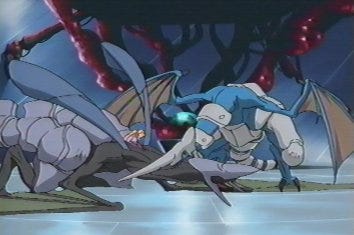 It's hard to develop attachment for a character in only one episode, but all Kyle seems to do is yell is his dragon for not listening and whine about saving his dear Alita.
It's hard to develop attachment for a character in only one episode, but all Kyle seems to do is yell is his dragon for not listening and whine about saving his dear Alita.
The lackluster plot isn't saved by the visuals either. A few of the segments -- notably the intro and any shot with the Empire ships -- are rendered with computer graphics that looks reasonably like the models used in the game cutscenes. For the time, they weren't too bad, but it greatly clashes with the hand drawn characters, so it isn't even all that visually appealing.
This is all really shameful, given the richly detailed world of Panzer Dragoon, which could have been brought to life if more time and talent had been capitalized on. The action scenes aren't that particularly good either. Similarly, the music is lacking -- the main theme seems to borrow a bit from the Saturn game, but most of the soundtrack is rather lousy.
Team Andromeda was dismantled after Panzer Dragoon Saga, with its members scattered to different parts of Sega -- and elsewhere, in the case of lead Yukio Futatsugi, who went to Microsoft Game Studios and eventually founded his own studio. Some were reassembled into Smilebit, another internal development team at Sega, for the production of Orta, but Sega ended its teams' autonomy once it merged with Sammy.
It seems unlikely that the world will see another Panzer Dragoon, despite how loudly fans voices cry for a remake or Panzer Dragoon Saga. However, the spirit lives on in other games, such as Sega's own cult classic Rez, which utilizes nearly the same play mechanics as Panzer Dragoon.
Panzer Dragoon Retrospective at 1UP
Panzer Dragoon Retrospective at Gamespot
The Art of Panzer Dragoon
GameSetWatch - Collector's Melancholy
Read more about:
FeaturesYou May Also Like